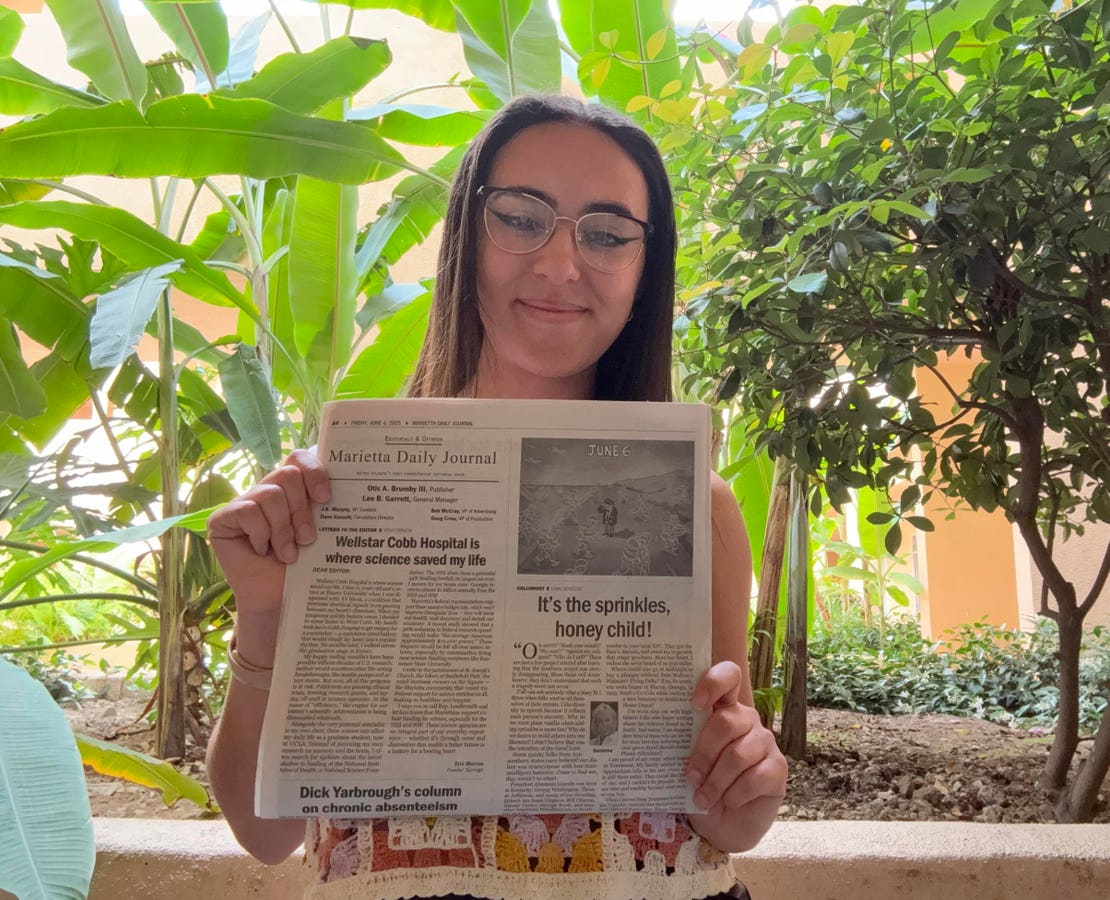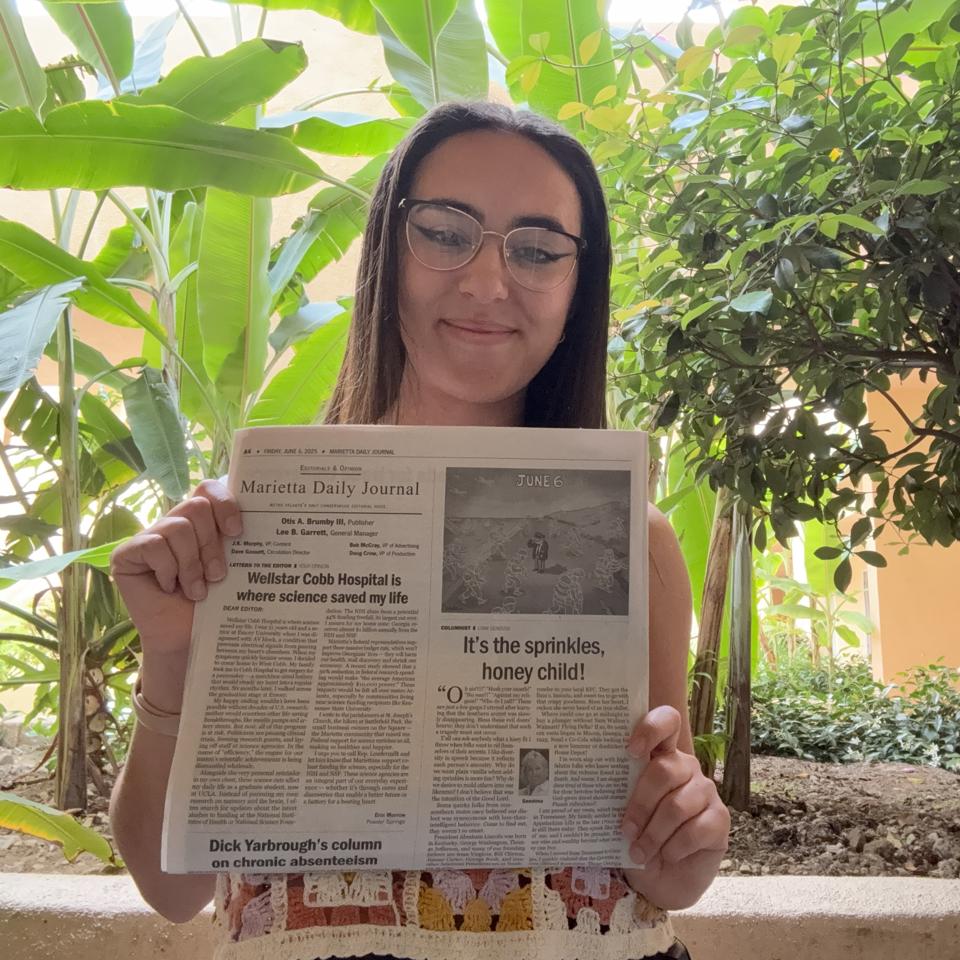Erin Morrow, a native of Powder Springs, Georgia, was diagnosed at age 20 with a cardiac conduction disorder that left her at risk of sudden cardiac arrest. A pacemaker implant made her recovery possible and allowed her to pursue a future in science. Now a PhD student in cognitive neuroscience at UCLA, she studies how emotion and stress shape the structure of our memories. Her work could improve diagnosis and treatment for PTSD. But her path to research is also a personal one. She credits decades of publicly funded research with enabling the treatment that saved her life.
Erin Morrow holds the printed version of her op-ed published in the Marietta Daily Journal.
This week, Morrow is one of hundreds of early-career scientists publishing opinion pieces in their hometown newspapers as part of a national campaign known as the McClintock Letters Project. The goal isn’t just to inform or persuade. It’s to reconnect. “I think it’s important to recognize as scientists that we’re first [humans] and scientists second,” Morrow said. Her op-ed, published in the Marietta Daily Journal in Georgia, where she grew up, recounts her experience undergoing surgery at a local hospital and explains how federally funded research made her treatment possible.
Amid polarized debate and funding under threat, graduate students from more than 100 institutions are turning to a distinctly low-tech form of outreach: the letter to the editor. Their goal isn’t just to save their grants—it’s to explain, in human terms, why science matters, and why it needs the public’s support. These young researchers, in the vanguard of American science, aren’t lobbying Congress. They’re writing to their neighbors.
A New Kind of Science Letter
The McClintock Letters Project began with a simple idea: that scientists could reach people more meaningfully — not just as experts, but as fellow citizens invested in the same shared future — not through national platforms, but by writing to the communities they came from.
The idea emerged earlier this year at Cornell University, where graduate students Isako Di Tomassi and Emma Scales, co-leaders of the Advancing Science and Policy (ASAP) Club, were looking for ways to mobilize students concerned with the increasing uncertainty in federal science funding. Di Tomassi and Scales wanted to elevate early-career scientists across disciplines in a way that would bring their work back to the communities they came from.
They teamed up with graduate student groups from more than 20 institutions, with organizing support from a national Slack network of early-career researchers focused on science policy. The goal: to coordinate the publication of 1,000 op-eds in local newspapers across all 50 states, timed to the week of June 16, the birthday of Nobel laureate Barbara McClintock.
What unites these pieces isn’t just their timing or format. It’s their method: personal storytelling. “We wanted scientists to explain what they do, why it matters, and how it connects to the communities they come from,” said Di Tomassi. “Not as an advocacy piece, but as a way to reconnect with the public.”
Who Was Barbara McClintock?
Barbara McClintock was a pioneering 20th century geneticist. Working largely on her own and often facing skepticism, she discovered “jumping genes” — mobile elements in DNA now called transposons that transformed the field of molecular biology. She received her PhD in botany from Cornell in 1927. In 1983, she became the first American woman to win an unshared Nobel Prize in science. Her discoveries in maize genetics laid the groundwork for everything from genetically modified crops to gene therapies in humans. Her legacy is a powerful reminder of the importance of basic research and the uniquely American infrastructure that supports it.
1947 portrait of Barbara McClintock (1902-1992) an American geneticist who won the 1983 Nobel Prize … More
What’s at Stake
The McClintock Letters campaign comes at a time of historic uncertainty for American science. Thousands of NIH and NSF grants — the lifeblood of basic research in the US — have been curtailed, delayed, or withdrawn. Among the most contentious proposed changes is a 15% cap on indirect cost recovery, a financing method used to support the basic operating costs of research institutions. The cumulative outcome of these disruptions has been terminations of staff, dismantling of labs, and what scientists describe as the “decimation” of support for the next generation of researchers.
According to data compiled by Grant Watch, a grassroots network of independent scientists documenting funding cuts, approximately $3.2 billion in NIH research funds have already been disrupted.
For many early-career scientists, the consequences are personal.
“Grad students are being affected by canceled training fellowships. Their PIs are having their NIH and NSF grants revoked or canceled. Clinical trials are getting canceled,” said Erin Morrow. “These are patients who are enrolling in these clinical trials as a last resort for the conditions that they’re in. So, yeah, it’s really disturbing.”
A recent federal court ruling by Judge William Young temporarily blocked some of the government’s plan to cancel NIH funding, offering a brief reprieve. But the broader future of federal support for science remains unsettled. That’s what prompted so many young scientists to speak out — not in protest, but in dialogue — with the communities that shaped them. They want those communities to understand that policy decisions made in Washington don’t just affect distant researchers at elite institutions. They shape the future of public health, education, and innovation in every part of the country.
Science with a Human Face
The McClintock Letters aren’t about policy details or partisan takes. They’re about people. They’re about early-career scientists like Isako Di Tomassi, a plant pathologist at Cornell, whose research was disrupted when her PhD advisor — an employee of the U.S. Department of Agriculture — was suddenly fired. Di Tomassi was forced to change labs and advisors, abandoning a major line of inquiry. One of her projects, a proposed genome-wide association study to identify virulence traits in Phytophthora infestans, the pathogen behind potato blight, was scrapped. Her experience illustrates how disruptions in federal research institutions ripple outward to shape the careers and contributions of young scientists.
Cornell student Isako Di Tomassi studies the fungus that causes potato blight.
“We believe science became too distant from the public,” explained Alex Rich, a 4th-year neuroscience PhD candidate at Yale University and one of the organizers. “We lost sight of the fact that all scientists come from communities, and that in many cases, they were inspired to pursue science by their communities, and the reason they do science is to give back to their communities.”
Another contributor, Margot Schmitt, a former inpatient social worker who now studies how alcohol use and aging affect brain structure, distilled her motivation in the Brattleboro Reformer this way: “To fix something, we need to understand it. To understand it, we need to study it. To study it, we need scientists and funding.”
Amanda Finn’s op-ed, entitled “In Defense of Education”, appeared in The Signal of Santa Clarita Valley, and shared how her path to a Ph.D. in nutrition science was shaped by family values and public investment. The daughter and granddaughter of Central American women who saw education as the one thing no one could take from you, Finn described learning how to do research through a federally funded NIH training program. She now studies how large-scale factors like neighborhood poverty limit health choices. “After all this work,” she wrote, “I can’t bear to see biomedical research be forever marred by Trump’s policies.”
Training a New Generation
For many contributors, writing an op‑ed required learning a new form of communication. At UCLA, Erin Morrow organized a writing workshop in her department to help peers think through narrative strategies for local audiences. Across the country, participants received similar support through informal peer networks and guidance from organizers.
Science Homecoming, a nonprofit that promotes public engagement by scientists, also offered free editorial feedback to any contributor who submitted a draft. The goal wasn’t just polish, but pedagogy. Participants learned to distill complex research into human terms and to write as scientists and neighbors.
“Often as trainees in science, we’re encouraged to take the personal out of the work that we do,” said Erin Morrow. “I really wanted this project to help bring people back to that space of thinking about the community that formed them.”
Organizers hope the McClintock Letters Project won’t be a one-off event. With over 1,000 scientists signing an accompanying open letter, the initiative is already seeding longer-term infrastructure for public engagement. The national Slack channel now serves as a coordinating hub for early-career researchers.
“We started a campaign — but I think we might have started a movement,” said Di Tomassi.
Yale student Alex Rich was one of the organizers of the McClintock Letters, a project by graduate … More
Leaning In
Some have described the policies of the Trump administration as a war on science. But, if it is, the McClintock Letters Project is not a counterattack. It’s an invitation. Rather than frame the current situation in terms of conflict, its organizers have chosen to lean into something quieter and harder: trust. That trust is not earned through credentials, but through openness. As Morrow explained in an interview, the premise of the project is that scientists are not just stewards of knowledge — they are members of communities, and their work can only be meaningful if it’s understood and valued by the society it’s meant to serve.
That’s why this campaign turns away from confrontation and toward connection. It asks scientists to step into the public square not as experts but as neighbors. And it encourages the public not just to defend science, but to claim it as their own.
A list of op-eds associated with the McClintock Letters project is available on their website.









